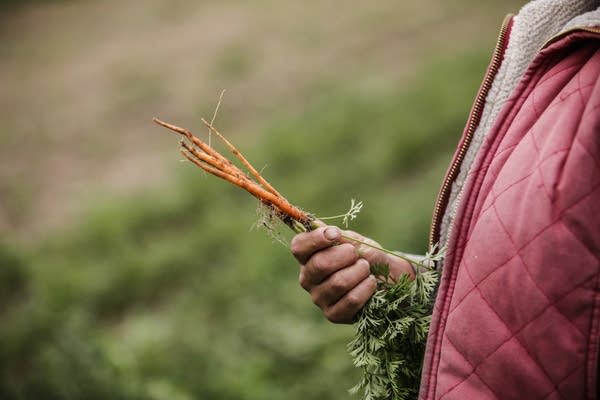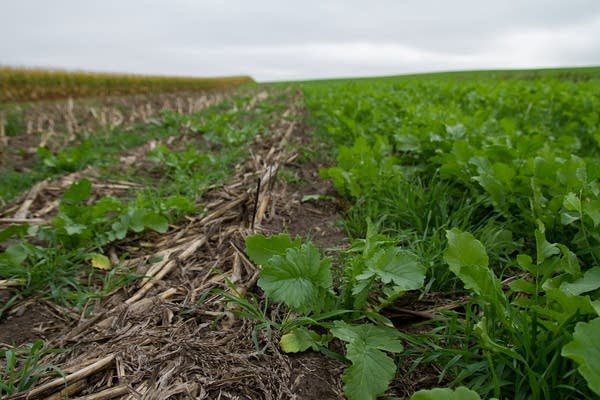Food and farming from Annual to Sugar beet

This handy guide should help you navigate the world of agriculture and food production. We'll be updating it periodically with new terms, so check back.
Acre
A unit of land area equal to 4,840 square yards. A football field is equal to about 1 1/3 acres. Acreage is one measure the U.S. Department of Agriculture uses to keep track of how much of each crop is grown and harvested each year.
Create a More Connected Minnesota
MPR News is your trusted resource for the news you need. With your support, MPR News brings accessible, courageous journalism and authentic conversation to everyone - free of paywalls and barriers. Your gift makes a difference.
Annual
A plant whose life cycle from seed germination to flower to seed takes place within a single growing season.
Apiculture
Raising bees for honey.

Aquaponic
A sustainable system of growing plants and fish, where fish waste fertilizes plants, such as salad greens.
Barrow
A castrated male pig. Barrows are castrated before reaching sexual maturity. They are less aggressive, can be mixed with gilts (female pigs that have not reproduced) and their meat is tastier than that of non-castrated males, which can produce a strong odor.
CSA
Community Supported Agriculture. The idea is that rather than a farmer growing a variety of vegetables, harvesting them and selling them in an open market, he or she instead recruits shareholders who pay a fee up front in exchange for boxes of fresh fruit and vegetables throughout the growing season.
CSA members take on some of the risk of vegetable farming, because there is no guarantee of which crops will do well or be wiped out by disease or extreme weather.
Cover crop
A crop planted primarily to prevent soil erosion before spring planting or after the fall harvest when the ground would otherwise be bare.
Cover crops can also be used to slow down weeds and boost soil health. Some cover crops are edible and can be harvested.

Ecosystem services
Positive benefits an ecosystem provides, such as cycling and moving nutrients or decomposing waste.
Recent efforts have attempted to quantify these services to better inform environmental decision-making.
Ethanol
A fuel made with corn and sometimes other plant materials. Most regular gasoline in the Midwest contains 10 percent ethanol. Some vehicles are able to run on an 85 percent ethanol blend, known as E85. Roughly 40 percent of the U.S. corn harvest goes to produce ethanol. An ethanol byproduct is distillers grain, which are fed to livestock.

Fertilizer
A natural or synthetic additive to make plants grow better by providing extra nutrients. Most agricultural fertilizers contain nitrogen, phosphorus and potassium.
Manure and other organic matter can also be used as fertilizers.
Hybrid
A seed produced from cross-pollinated plants, usually to emphasize certain traits.
Kernza
A perennial wheat grass developed by The Land Institute in Kansas. It's being tested in Minnesota, and companies like General Mills have invested in it.

It has deep roots, assists in retaining clean water and stores more carbon in the soil than other crops.
Kohlrabi
A vegetable in the cabbage family that grows well in the Midwest. Unlike the more leafy cabbage, it's a chunk of meaty green that can be sliced up and cooked or eaten raw.
Passive solar
A building design that involves special insulation, ventilation and orientation to capture the sun's warmth in the winter and reject it in the summer.
Perennial
A plant that lives through many growing seasons. Many perennials' leaves die during the winter and grow back in the spring.
Permaculture
A type of agricultural design aimed at mimicking natural ecosystems.

Permaculture is becoming a popular idea in designing urban landscapes, and some farmers are also experimenting with permaculture principles to boost soil health and resilience, support biodiversity, restore pollinator habitat and protect water quality.
Sugar beet
Minnesota's fifth largest crop by acreage, sugar beets are a white-fleshed root vegetable made up of about 18 percent sucrose. They are processed into sugar.